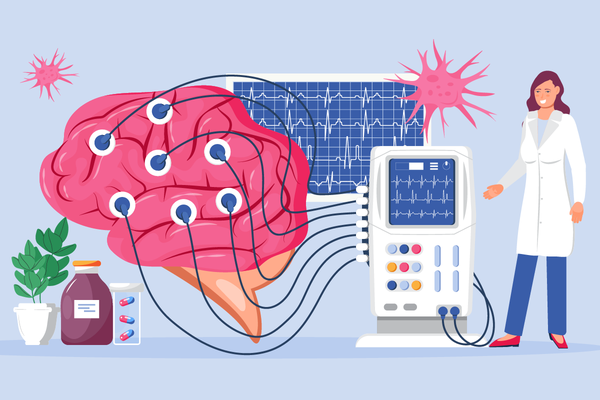Candice Morgan blamed her bouts of dizziness on hunger or being tired. The Detroit, Michigan-based IT professional took a pregnancy test, even though she knew she wasn’t pregnant. Ten days later, she went to the hospital, where doctors took a CT scan and kept her overnight for observation. The next day, doctors ordered an MRI and confirmed her diagnosis: Morgan had multiple sclerosis.
She was two weeks shy of her 33rd birthday, and she was in utter shock.
“That's a full-blown disease. I came here to figure out what's going on this week, and you're telling me that I have a disease. How could that be?” she recalled thinking. “Once I got over that initial shock, I was like, OK, I am slowly going to lose my physical capabilities.”
What is MS and who gets it?
Morgan is among the 1 million people in the United States living with multiple sclerosis (MS), which is an autoimmune disease of the nervous system. The immune system attacks myelin, the outer protective layer of the brain’s nerve fibers, cutting off communication between the brain and the body, leading to physical damage throughout the body.
There are four types of MS: clinically isolated syndrome (CIS), relapsing-remitting MS (RRMS), primary progressive MS (PPMS), and secondary progressive MS (SPMS). CIS is a single neurological episode lasting 24 hours, caused by inflammation and loss of myelin. While it may represent the onset of MS, for some, this may be their only episode. If an MRI reveals brain lesions, there’s a higher likelihood that the person will have another episode and will eventually be diagnosed with RRMS.
Eighty-five percent of Americans with MS are initially diagnosed with RRMS, which means they experience sudden attacks followed by periods of remission when they don’t experience symptoms. The other 15% have progressive MS, either primary or secondary, which means symptoms gradually worsen.
Women are three times more likely than men to get the disease, and most start experiencing symptoms between ages 20 and 40. While it’s widely believed that MS is most common in white people, a Kaiser Permanente study found that Black people had a 47% increased risk of MS, with Black women having the highest risk. Latinx people had 50% less risk, and Asians had 80% less risk.
Morgan, who is Black, said her prior knowledge of MS came from Michelle Obama’s speeches referencing her own mother, who had the disease, and a friend’s mom, who had the disease and was unable to walk. When going in for treatment, she often felt alone, seeing no other Black women around.
It wasn’t until she started sharing her diagnosis that she learned some of her own friends had the disease. That’s when she joined We Are ILL, a patient advocacy organization that raises awareness about Black women and MS.
Symptoms of MS
MS symptoms can vary because the effects of the disease are largely dependent on what part of the brain is being attacked, explained Dr. Diana Lucia Vargas Vives, a neuroimmunologist with expertise in multiple sclerosis and assistant professor at Emory School of Medicine.
There is also a pattern to how MS presents, she said.
“Patients might wake up with a numb foot. Then it suddenly goes away after a few days, so they think they’re fine. Years later, they may have vision loss in one eye that’s lasting for days to weeks, and that’s when they start seeking help. Patients may also have extreme fatigue and become forgetful,” Dr. Vargas said.
That’s exactly what Meredith O’Brien experienced at 43. She started feeling numbness in her left leg, which spread through her torso. It came and went, but 10 days later, she went to her doctor, who ran her blood work, tested her for Lyme disease and ordered an MRI. The initial MRI was inconclusive, so O’Brien was sent to a neurologist. After more testing, she was told her symptoms were psychosomatic (created by a psychological condition). Her symptoms soon disappeared, so she moved on.
But two years later, her symptoms roared back. The numbness was much more aggressive, she had blurred vision, the heat would make her vomit and previously easy tasks would leave her drained. This time, she went to an MS specialist who diagnosed her with the disease after another MRI.
“It was like, OK, this actually is real — and then I was kind of relieved that I knew what this was,” said O’Brien, who wrote about her 2013 diagnosis in her memoir, “Uncomfortably Numb.”
How MS is diagnosed
When diagnosing MS, doctors now have strict criteria and must rule out other diseases.
“The purpose of these criteria is to try to diagnose early. You have to have an MRI of your neuroaxis, which means an MRI of your brain, cervical and thoracic spine,” said Dr. Vargas. “That shows what we call white matter lesions. We start with the imaging, and then rule out mimickers that could present [similarly] to MS.”
That includes autoimmune diseases like lupus and Sjogren’s syndrome, and nervous system disorders like neuromyelitis optica, which can be ruled out with antibody testing. More obscure diseases like sarcoidosis can also look like MS on an MRI.
“Oftentimes, it is clear that the lesions are characteristic of MS,” said Dr. Vargas. “Sometimes, we have to aid diagnosis with a lumbar puncture [spinal tap].”
You can live a normal life
While MS can get worse over time, treatment has come a long way in keeping the disease at bay.
“Therapy has changed the way that MS has behaved. Before, when you were diagnosed with MS, 15 years later, there was about a 60% chance that you were going to require assistance to walk,” Dr. Vargas explained. “Now, that number has decreased to 11%.”
There are nearly two dozen drugs used to treat MS. With early intervention, these drugs can significantly slow down development of new lesions and prevent relapses. But these drugs can have side effects, from exhaustion to nausea and even liver damage.
Doctors will prescribe the type of medication and delivery method based on a patient’s severity of disease, what they are willing to take and how they respond, Vargas said.
For example, Morgan was first prescribed one medication, but had extreme exhaustion as a side effect. This led her to be inconsistent in taking it, which led to a scary flare-up last year. Her doctor switched her to infusions of another medicine, and she finds that the new treatment suits her much better.
O’Brien takes one medicine for her MS, but she also has to take individual medications to tackle the leg spasms that keep her up at night, the migraine attacks and the nausea she experiences.
Both women continue to work and stay active.
“You can live a normal life and do the things you love. But you will have a lifelong neurologist and you’ll need to take your medication,” said Vargas, who added that she also prescribes vitamin D, a healthy diet and exercise.
“MS is not a death sentence,” Morgan said. “You can have a family, you can have a career. You can flourish. I’m living proof of that.”
This resource was created with support from Bristol Myers Squibb.
- What You Need to Know About Multiple Sclerosis - HealthyWomen ›
- Fact Facts: Everything You Need to Know About Multiple Sclerosis ... ›
- HealthyWomen's Multiple Sclerosis (MS) Support Group Finder ... ›
- Can I Prevent Multiple Sclerosis - HealthyWomen ›
- How Multiple Sclerosis Affects the Central Nervous System - HealthyWomen ›
- Questions to Ask Your Neurologist If You Have MS - HealthyWomen ›







